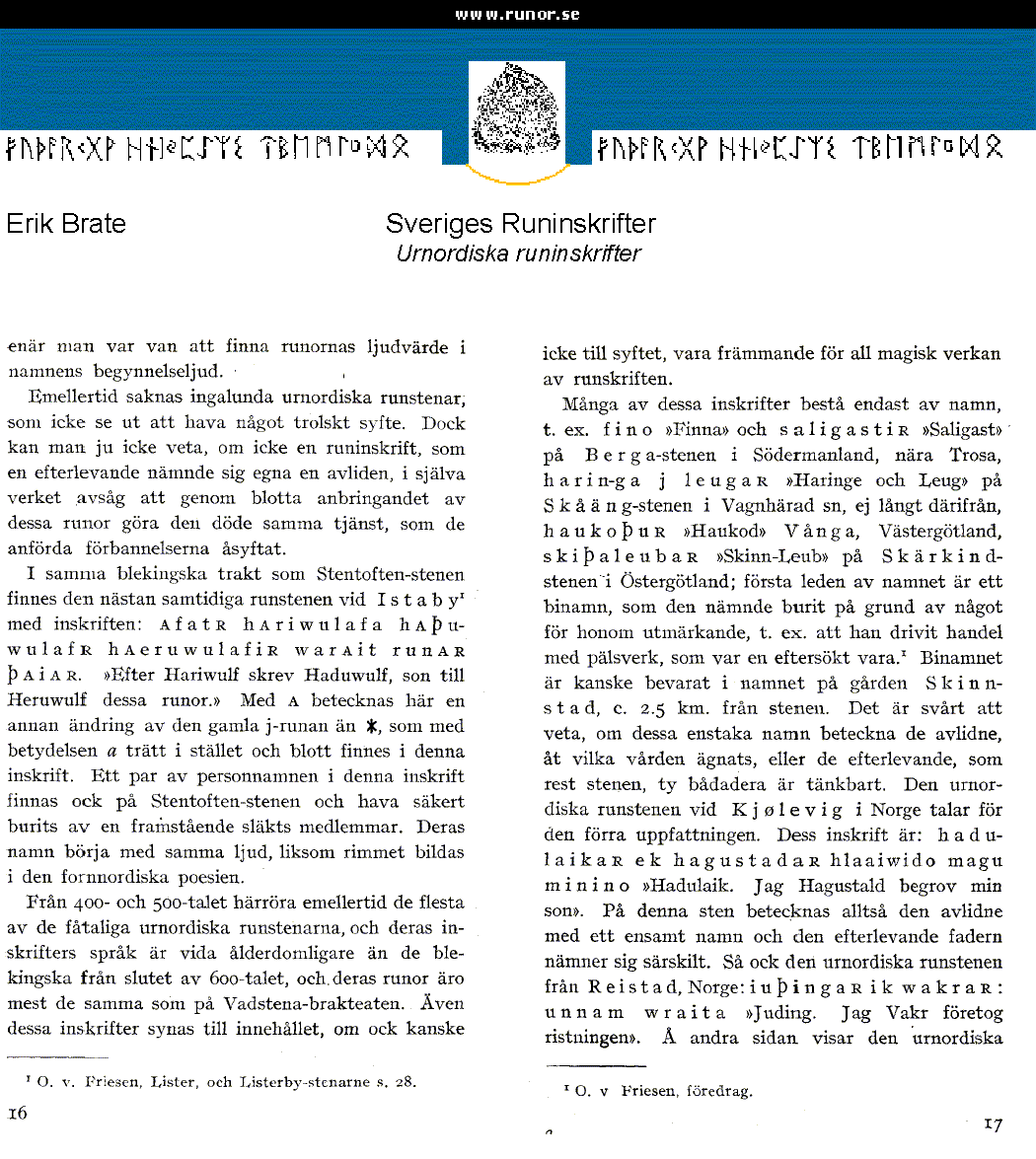
since one were used to find the
rune sound in the beginning of names
initial sound.
However most of Nordic rune
stones seem to have some magic aim. However, one can of course not
know, if a runic inscription, dedicate to a relative intended that
through exposing these runes
it will give the dead service,
as the stated curses aimed at. In the same region in Blekinge were the
Stentoften-stone were found there is nearly a contemporary rune stone
at Istaby (1) with the inscription:
AfatR hAriwulafa
hAþuwulafR hAeruwulafiR warAit runaR þAiAR. “After Hariwulf wrote
Haduwulf, son to Heruwulf these runes.” With A denoted
here is another change of the old j-rune than*, with the meaning a is only found in this inscription. Some of the person
names in this inscription exist also on Stentoften-stone and have
probably been carried of prominent related members. Their names begin
with the same sounds, like the rhyme to be formed in the Nordic poetry.
From 5th century
and 6th century originate most of the small number of Nordic
rune stones, and their inscription languages are wide old- fashioned
compare to the blekingska from the end of 7th century, and
their rune very the same as on Vadstena – bracteates. Even these
inscriptions are inspected to contained, and maybe
(1) O. v. Friesen, Lister and Listerby-stenarne s. 28.
not to the aim, be unknown for
all magic effect of the runic inscription.
Many of these inscriptions consist only of names, e.g. fino “find” and saligastiR ”last " on Berga-stone in Södermanland, near Trosa,
hariŋa j 1eugaR
“Haringe and Leug” on Skåäng- stone in Vagnhärad sn, not far from there,
haukoþuR
”Haukod " Vånga, in Västergötland,
skiþaleubaR
“Skinn-leub” on Skärkind-stone in Östergötland; the first part of the name is a byname, as the mentioned carried because of some for him significant, that he make trade with furs that were much coveted,(1) Byname is perhaps preserved in the name on the farm Skinnstad, c. 2.5 km from the stone. Its difficult to know if these occasional names refer to the deceased, or to the surviving relative, that raised the stone, both is possible. The Nordic rune stone at Kjolevig in Norway speaks for the previous view. Its inscription is:
hadulaikaR ek hagustadaR hlaaiwido magu minino
"Hadulaik. I Hagustald buried my son".
On this stone is the deceased mentioned as single-name while the father mentions himself special. So on the Nordic rune stone from Reistad, Norway:
iuþingaRik wakraR: unnam wraita
“Juding. I Vakr carried out the inscription”. On the other hand, the Old Nordic shows
Many of these inscriptions consist only of names, e.g. fino “find” and saligastiR ”last " on Berga-stone in Södermanland, near Trosa,
hariŋa j 1eugaR
“Haringe and Leug” on Skåäng- stone in Vagnhärad sn, not far from there,
haukoþuR
”Haukod " Vånga, in Västergötland,
skiþaleubaR
“Skinn-leub” on Skärkind-stone in Östergötland; the first part of the name is a byname, as the mentioned carried because of some for him significant, that he make trade with furs that were much coveted,(1) Byname is perhaps preserved in the name on the farm Skinnstad, c. 2.5 km from the stone. Its difficult to know if these occasional names refer to the deceased, or to the surviving relative, that raised the stone, both is possible. The Nordic rune stone at Kjolevig in Norway speaks for the previous view. Its inscription is:
hadulaikaR ek hagustadaR hlaaiwido magu minino
"Hadulaik. I Hagustald buried my son".
On this stone is the deceased mentioned as single-name while the father mentions himself special. So on the Nordic rune stone from Reistad, Norway:
iuþingaRik wakraR: unnam wraita
“Juding. I Vakr carried out the inscription”. On the other hand, the Old Nordic shows
(1) O, v Friesen, lecture.